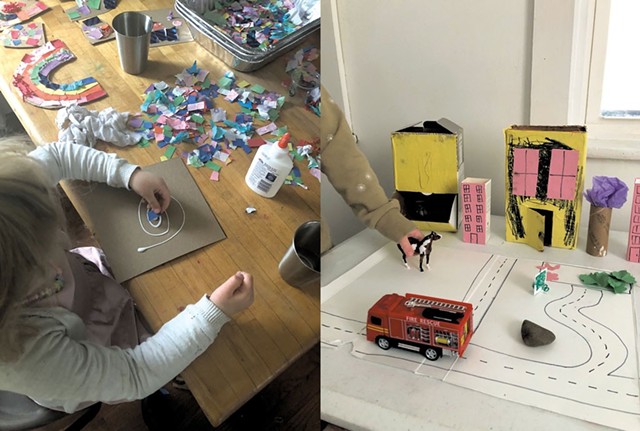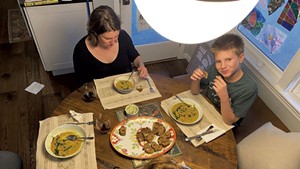
- Meredith Bay-Tyack
- Left: Collage is an easy and adaptable activity; Right: Build a tabletop city with recycled material
We are parenting at a time when magazines, blogs, Pinterest, Instagram and YouTube are filled with crafty ideas for keeping our kids entertained and educationally enriched. It can be inspiring — and overwhelming. I enjoy doing projects and crafts with my kids, but I find pulling back and keeping it simple can yield lovely results. And despite what your online browsing might suggest, crafting doesn't require glitter (aka microplastics that pollute the environment). Here are six low-waste and low-cost ideas for sparking creativity and open-ended play.
1. Make your own games
Our house, like many, has a stock of puzzles and games. The other day I wanted to play a childhood favorite, mancala, but we don't have it. I realized we could make our own board with a clean egg carton and two bowls. Make your own puzzle by pasting a photo or piece of art onto cardboard and cutting out shapes as simple or as complex as your imagination and ability allow. Matching and memory games are also fun activities to create and play. Or take it to the next level and make up your own game. Use bottle caps, small toys or your own Candy Land-style figures to travel around the board. Try this at your own risk, though. My 5-year-old developed her own game that I never quite understood and, therefore, continued to lose!
2. Binoculars, spy glasses and wands, oh my!
Toilet tissue and paper towel rolls are the ideal size and shape for a variety of crafts. Tape or glue two together, add a string and decorations, and go birdwatching with your new binoculars. Save a piece of plastic film and use a rubber band to attach it to one end of a tube. Now hike around your neighborhood or house and go on a scavenger hunt. Look for circles, for blue things, or for sparkly things, and put them in the tube. Ribbon wands are a favorite of ours and are easy to make: Gather ribbon, yarn or even thin strips of scrap fabric. Staple or glue them to one end of a tube. Add more decorations like washi tape and paint — or not. Swinging the wand around makes the ribbons bounce and dance no matter how artfully designed it is. Bonus idea: Close off one end of a tube with masking tape or a small cloth and rubber band. Fill with small items like caps, hard plastic (that parents safely cut up) or even small rocks. Then close the other end, and you've got a music shaker.
3. Build fairy houses and cities
Building cities and fairy houses is a classic "reuse your recycling" idea for good reason. The level of detail depends on kids' ages and parents' willingness to take on some crafting. I happen to enjoy getting in there with scissors and other supplies to transform old creamer cartons and pasta boxes into buildings. Add a few small Lego figures or other small toys, and the playscape really comes alive. A simpler idea with a similar outcome is to lay out a flattened box or large piece of cardboard and draw roads and houses. Add some toy cars and blocks or magnetic tiles.
4. Collage with magazines, paper, old art and cardboard
The only essential ingredient in creating a collage is glue or tape. All other methods and materials are up to the maker. If infinite combinations make your eyes cross, try these three methods to keep it manageable. If a blank piece of paper feels intimidating, start with a newspaper page, photograph or piece of art. Then layer ripped paper, scraps of fabric, yarn and, if you'd like, paint on top. The second collage technique requires a bit more preparation but yields lovely results. Cut a rainbow shape out of cardboard. Then, cut or rip up colored paper, magazines and older art in all colors. Glue the collage in a rainbow pattern. The effect is exciting for kids and adults. Decorate both sides, and hang your artwork from the ceiling or in a window. Finally, try this idea inspired by art educator Barbara Rucci: Start with a circle of cardboard, then cut a variety of smaller shapes, also from cardboard. Plan out, then glue together to make a cardboard face. Make it a self-portrait, a silly imaginary character or the family pet. Add crayons or paint after it dries for a three-dimensional masterpiece.
5. Play dough
We make our own play dough because it's fast and simple. Sometimes we add color, sometimes cinnamon or raw cacao so it smells nice. On days when we need something extra, we add a drop of essential oil and put on classical music while we create with the dough. (Research what oils are kid-safe.) There are many play dough recipes online that call for a few basic ingredients. We use a baking soda and cornstarch-based recipe from the website makeandtakes.com because it is gluten-free (I have celiac disease). Store dough in a glass jar in the fridge for future play.
6. Loose parts play
Loose parts are collections of small items that are easy for little hands to grasp. They can be mixed up, lined up, arranged in patterns and used in countless open-ended ways. I first learned about loose parts play from parents who shared beautiful wooden sets of rainbow-hued rings, coins, cones and other shapes. Turns out any collection of small items can be used in a similar way. Some favorites of ours are corks, bottle caps, marbles, smooth rocks, sticks, acorns and felt balls. There are two aspects to loose parts: the objects themselves and their setting or application. Loose parts can be laid out in careful concentric circles like a mandala. Set out small bowls and cups and watch kids open a restaurant. Pair loose parts with play dough or kinetic sand, and imaginary worlds emerge. Simply let the small pieces guide your kids' imagination.
Quick tip: One way to kick-start independent play if kids don't seem interested is to sit down for a few minutes and play along with them. Depending on the day, I may relish the opportunity to get silly or I may groan that I have to pause my other projects, but it almost always works to get my kids engaged.
Resources for further exploration
- Check out artcampla.com/blog.
- Read Art Workshop for Children: How to Foster Original Thinking With More Than 25 Process Art Experiences by Barbara Rucci.
- Visit the websites of locally operated Owl Feet studio in Charlotte (owlfeetstudio.com) and Wildflowers Studio in Essex Junction (wildflowerstudiobtv.com).











Comments
Comments are closed.
From 2014-2020, Seven Days allowed readers to comment on all stories posted on our website. While we've appreciated the suggestions and insights, right now Seven Days is prioritizing our core mission — producing high-quality, responsible local journalism — over moderating online debates between readers.
To criticize, correct or praise our reporting, please send us a letter to the editor or send us a tip. We’ll check it out and report the results.
Online comments may return when we have better tech tools for managing them. Thanks for reading.